The initial indifference, and later open hostility, of the prefects and later the procurators, to their Jewish subjects eventually led to a revolt against Rome in 66 CE. Somewhat surprising, in light of their poor attitude towards the Jews, the small bronze prutahs issued by the prefects abided by the strict interpretation of the Commandment against graven images. Except for the pagan religious symbols on the coins of Pontius Pilate the designs were probably not objectionable to the citizenry.
The first design introduced by the prefect Coponius (6-9 CE) - the palm tree - had heretofore appeared only on extremely rare coins of Herod Antipas; this ultimately became the quintessential symbol of Judaea on coins issued by the Jews during the First and Second Revolts, as well as later Roman-issued Judaean-related pieces. (#40) The next Prefect, Ambibulus (9-12 CE) continued the palm tree and ear of barley designs. (#41, 42, 43) The Latin inscription is the Emperor's title -- KAICAP (Caesar). It should be noted that all prefect and procurator coins can be precisely dated since the regnal year (A=1, B=2, etc) of the Roman Emperor is indicated following the letter "L".

#40 Coponius 5/6 CE (H-1328)
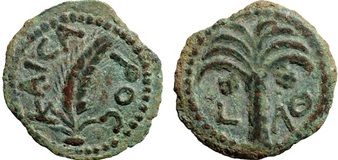
#41 Ambibulus 8/9 CE (H-1329)

#42 Ambibulus 9/10 CE (H-1330)


#43 Ambibulus 10/11 CE (H-1331)
Annius Rufus (12-15 CE) evidently did not issue any coins. However, Valerius Gratus (15-26 CE), prefect under Emperor Tiberius, issued coins with the Caesar's title within a wreath, and the Emperor's name "TIB" and regnal year (LB = Tiberius' second year = 15/16 CE) above two cornucopiae (reverting back to the familiar Hasmonean and Herodian design). (#44) Gratus issued a number of other coin types - upright leafy branch (#45), double cornucopiae with caduceus within (#46), three lilies (#47), grape vine leaf and amphora (#48, 49), and palm branch (#50) -- during his long rule. These coins are inscribed with the name of the Emperor or his mother, Julia (IOYLIA).


#44 Gratus 15/16 CE (H-1332)
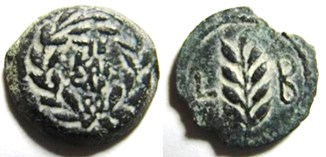
#45 Gratus 15/16 CE (H-1333)


#46 Gratus 16/17 CE (H-1334)
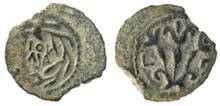
#47 Gratus 16/17 CE (H-1335)

#48 Gratus 17/18 CE (H-1338)
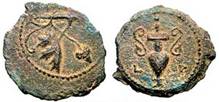
#49 Gratus 17/18 CE (H-1336)


#50 Gratus 17/18 CE (H-1338)

#51 Gratus 18/19 CE (H-1339)

#52 Gratus 24/25 CE (H-1340)
Philo of Alexandria (c. 20 BCE – c. 50 CE ) depicted the next prefect (Pontius Pilate) appointed by Tiberius as “by nature unyielding and of a stubborn harshness.” During his rule (26-36 CE) two new coin types appeared that include pagan religious symbols. The first has three ears of barley surrounded by the legend IOYLIA KAICAPOC (Julia Caesar, wife of the Emperor), and a simpulum (Roman ceremonial dipper) with the Emperor's name and regnal year. (#53) The second type was issued in the year of Jesus' crucifixion -- 30/31 CE - (#54) and the following year (#55); these coins feature a curved litiuus (augur's wand), which was used by certain Roman priests to determine the future.
Note that Pontius Pilate's title was traditionally thought to have been procurator, since Tacitus speaks of him as such. However, an inscription on a limestone block known as the Pilate Stone — a dedication to Tiberius Caesar Augustus — that was discovered in 1961 in the ruins of an amphitheater at Caesarea Maritima refers to Pilate as "Prefect of Judaea."

The
partial inscription reads:
[DIS AUGUSTI]S TIBERIÉUM
[...PO]NTIUS PILATUS
[...PRAEF]ECTUS IUDA[EA]E
[...FECIT D]E[DICAVIT]
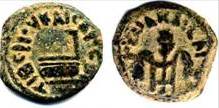
#53 Pilate 29/30 CE (H-1341)

#54 Pilate 30/31 CE (H-1342)

#55 Pilate 31/32 CE (H-1343)
Pontius Pilate was suspended from his office by the Vitellius, legate (ambassador) to Syria, after Pilate's forces had brutally quashed a gathering of Samaritans on Mount Gerizim. He was succeeded by Marcellus (36-37 CE) and Marullus (37-41 CE), who left no mark in history (including no coins). The next three governors of Judaea, appointed by Emperor Claudius, also did not minted coins: prelates Cuspius Fadus (44-46 CE) and a Jewish apostate Tiberius Alexander (46-48 CE), and procurator Ventidus Cumanus (48-52 CE). The fires of revolt were lit under the heavy-handed treatment of Cumanus, who was eventually deposed and exiled by Claudius.
Nikos Kokkinos writes in “The Prefects of Judaea 6-48 CE and the Misty Period 6-36 CE” (“Judaea and Rome in Coins,” Spinks, 2012): “The change of title from praefectus to procurator for equestrian governors under Claudius, took place, in the case of Judaea, arguably after 48 CE and before or by 52 CE.”
Procurator Antonius Felix (52-59 CE) married a member of the Jewish royal family - Drusilla - sister of Herod Agrippa II. Unfortunately, reports the historian Tacitus, Felix acted as if he had arrived in a country which existed only to be exploited for his own advantage, and after a tumultuous period he was recalled by Rome. The small bronze coins of Felix introduce new types: crossed palm branches (#56), and crossed shields with a palm tree (#57). The first coin issued by Felix carries the names of the Emperor Claudius and his wife (who was also his niece) Agrippina; the second type features the names of Nero and his brother Britannicus (who he poisoned in 55 CE).
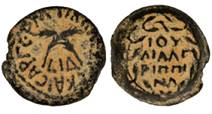
#56 Felix 54 CE (H-1347)

#57 Felix 54 CE (H-1348)
Recent scholarship by Ya'akov Meshorer indicates that "Festus apparently assumed office in 59 CE. His only issue ... was struck immediately upon his arrival in Judaea." These coins feature a palm branch and the Emperor Nero's name. (#58) Festus showed sensitivity to his Jewish subjects, but it was he who "said with a loud voice, Paul, thou art beside thyself; much learning doth make thee mad" (Acts 26:24).

#58 Festus 59 CE (H-1351)
No coins are known of the last two procurators - Albinus (62-64 CE) and Gessius Florus (64-66 CE). The brief rule of Albinus completely undid the little good his predecessor had accomplished. The historian Josephus wrote: "There was no sort of wickedness that he did not have a hand in. In his political capacity, he stole and plundered everyone's substance." About Albinus' successor, Tacitus wrote: "Jewish patience lasted until the coming of Gessius Florus." Florus committed acts of flagrant injustice, giving free rein to thieves, and reducing whole communities to misery. Thus a revolt was virtually inevitable.
© 2020-Mel Wacks